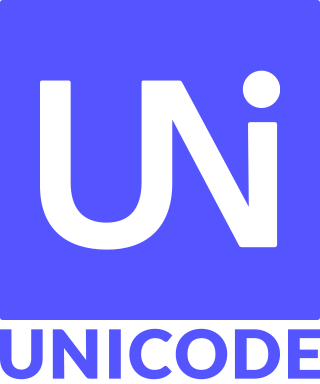Related Research Articles

Unicode, formally The Unicode Standard, is a text encoding standard maintained by the Unicode Consortium designed to support the use of text in all of the world's writing systems that can be digitized. Version 16.0 of the standard defines 154998 characters and 168 scripts used in various ordinary, literary, academic, and technical contexts.

GB 18030 is a Chinese government standard, described as Information Technology — Chinese coded character set and defines the required language and character support necessary for software in China. GB18030 is the registered Internet name for the official character set of the People's Republic of China (PRC) superseding GB2312. As a Unicode Transformation Format, GB18030 supports both simplified and traditional Chinese characters. It is also compatible with legacy encodings including GB/T 2312, CP936, and GBK 1.0.

Unicode has text representations of chess pieces. These allow to produce the symbols using plain text without the need of a graphics interface. The inclusion of the chess symbols enables the use of figurine algebraic notation, which replaces the letter that stands for a piece by its symbol, e.g. ♘c6 instead of Nc6. This also allows the play of chess games in text-only environments, such as the terminal.
A Unicode block is one of several contiguous ranges of numeric character codes of the Unicode character set that are defined by the Unicode Consortium for administrative and documentation purposes. Typically, proposals such as the addition of new glyphs are discussed and evaluated by considering the relevant block or blocks as a whole.
In Unicode, a Private Use Area (PUA) is a range of code points that, by definition, will not be assigned characters by the Unicode Consortium. Three private use areas are defined: one in the Basic Multilingual Plane, and one each in, and nearly covering, planes 15 and 16. The code points in these areas cannot be considered as standardized characters in Unicode itself. They are intentionally left undefined so that third parties may define their own characters without conflicting with Unicode Consortium assignments. Under the Unicode Stability Policy, the Private Use Areas will remain allocated for that purpose in all future Unicode versions.
Geometric Shapes is a Unicode block of 96 symbols at code point range U+25A0–25FF.
Letterlike Symbols is a Unicode block containing 80 characters which are constructed mainly from the glyphs of one or more letters. In addition to this block, Unicode includes full styled mathematical alphabets, although Unicode does not explicitly categorize these characters as being "letterlike."
Block Elements is a Unicode block containing square block symbols of various fill and shading. Used along with block elements are box-drawing characters, shade characters, and terminal graphic characters. These can be used for filling regions of the screen and portraying drop shadows. Its block name in Unicode 1.0 was Blocks.
The Chinese, Japanese and Korean (CJK) scripts share a common background, collectively known as CJK characters. During the process called Han unification, the common (shared) characters were identified and named CJK Unified Ideographs. As of Unicode 15.1, Unicode defines a total of 97,680 characters.
Specials is a short Unicode block of characters allocated at the very end of the Basic Multilingual Plane, at U+FFF0–FFFF. Of these 16 code points, five have been assigned since Unicode 3.0:
The Basic Latin Unicode block, sometimes informally called C0 Controls and Basic Latin, is the first block of the Unicode standard, and the only block which is encoded in one byte in UTF-8. The block contains all the letters and control codes of the ASCII encoding. It ranges from U+0000 to U+007F, contains 128 characters and includes the C0 controls, ASCII punctuation and symbols, ASCII digits, both the uppercase and lowercase of the English alphabet and a control character.
Latin Extended-A is a Unicode block and is the third block of the Unicode standard. It encodes Latin letters from the Latin ISO character sets other than Latin-1 and also legacy characters from the ISO 6937 standard.
Enclosed Alphanumerics is a Unicode block of typographical symbols of an alphanumeric within a circle, a bracket or other not-closed enclosure, or ending in a full stop.
The Unicode Standard assigns various properties to each Unicode character and code point.
CJK Symbols and Punctuation is a Unicode block containing symbols and punctuation used for writing the Chinese, Japanese and Korean languages. It also contains one Chinese character.
Kana Supplement is a Unicode block containing one archaic katakana character and 255 hentaigana characters. Additional hentaigana characters are encoded in the Kana Extended-A block.
General Punctuation is a Unicode block containing punctuation, spacing, and formatting characters for use with all scripts and writing systems. Included are the defined-width spaces, joining formats, directional formats, smart quotes, archaic and novel punctuation such as the interrobang, and invisible mathematical operators.

Enclosed Ideographic Supplement is a Unicode block containing forms of characters and words from Chinese, Japanese and Korean enclosed within or stylised as squares, brackets, or circles. It contains three such characters containing one or more kana, and many containing CJK ideographs. Many of its characters were added for compatibility with the Japanese ARIB STD-B24 standard. Six symbols from Chinese folk religion were added in Unicode version 10.
Ol Chiki is a Unicode block containing characters of the Ol Chiki, or Ol Cemet' script used for writing the Santali language during the early 20th century.
KS X 1002 is a South Korean character set standard established in order to supplement KS X 1001. It consists of a total of 7,649 characters.
References
- ↑ "Unicode character database". The Unicode Standard. Retrieved 2024-09-10.
- ↑ "Enumerated Versions of The Unicode Standard". The Unicode Standard. Retrieved 2024-09-10.